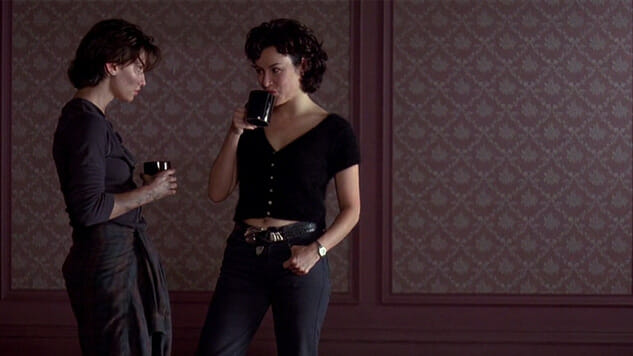
“Define Frenzy” is a series essays published throughout Pride Month attempting to explore new queer readings or underseen queer films as a way to show the expansiveness of what queerness can be on screen. You can read previous years’ essays here.
Before Lana and Lilly came out as trans, the Wachowski sisters were in tune with how to access queerness in film better than most directors could ever hope to be. From the latex clad characters of The Matrix, to the aesthetic excess of Speed Racer, to the radical androgyny of V for Vendetta (for which they wrote the screenplay), the Wachowskis’ work could always be viewed through a queer lens. But they made their impact as queer filmmakers right out of the gate with Bound, their Wilder-esque feature film debut from 1996 that queers neo-noir and lets it sizzle.
When Violet (Jennifer Tilly) spots a tattoo on Corky’s (Gina Gershon) bicep, she knows. Cruising can be for later, but for now, in the elevator, Violet, who happens to be the wife of a gangster, has set her erotic crosshairs on Corky, an ex-con working as a contractor of sorts in the adjacent apartment. The tattoo is of a labrys, a double-headed axe, a tell tale sign for queer women, whose origins are connected to the Greek goddess of the hunt, Artemis, and of the harvest, Demeter. The two lock eyes briefly, but Violet is sure to make the first move, dropping her earring in the sink.
Steeped in an awareness of lesbian culture, Bound frames the erstwhile affair as both hard boiled and honest. The sex can be explicit, but the subtle coding and code switching of its two leads—both intentionally playing with femme and butch roles; Violet speaking to Corky in a deeper, huskier voice, contrasted against her infantilized elocution to the men in her life—the way they look, speak and touch one another, it all drips in specificity, both to regarding the film’s queerness and the characters’ personalities. The sex seems to solidify what Violet and Corky want to find in one another: a way out of mobster life for the former, and a commitment for the latter.
While the difference in gender presentation between Violet and Corky is compelling, what is of more interest is their class differences, augmented in Violet’s initial seduction of Corky. Dropping a teardrop earring down the sink juxtaposes their class backgrounds, with the accessory evidence of Violet’s privileged life, and the task designated as required given Corky’s job title. Violet’s chic leather jacket does not subdue her affluence, even if that affluence comes via her crooked husband, Caesar (Joe Pantoliano). Wealth and extreme violence halve Violet’s life as a man is brutally knocked off in her once immaculate bathroom. The Wachowskis smash cut to Violet using the blender in her even sleeker kitchen. In comparison, Corky revels in the grease, dirt and fringes of harder labor; her apartment is barer. Her environment not only articulates her butch qualities against Violet’s more femme attributes, but also codes her as working class.
That doesn’t mean she isn’t interested in climbing an economic ladder, however. She quips to Violet in bed that she spent five years in jail for “the redistribution of wealth,” a line she admits to using to get women into bed. Violet takes notes of these skills, and presents Corky with a plan to steal $2M from Caesar and the mob.
It’s interesting, then, that Violet sees Corky as her “way out,” her “key to a different life.” The occasional conflict that arises between the two has to do with “who they are,” with Corky’s slight skepticism of Violet’s lesbianism. But Violet, as their plan becomes more of a sure bet, almost invokes a subjectivity within the film, wit its highly stylized aesthetic. Aided by Bill Pope’s cinematography, Violet conceives her aspirational getaway as fantasy, as if something like Double Indemnity or Thelma & Louise really were playing in her head.
While the Wachowskis’ dialogue is servicably comparable to that of Raymond Chandler, more impressive is their ability, as well as Gershon and Tilly’s, to articulate that Violet and Corky have found what they need in one another almost wordlessly. Not only is this realization in their looks at one another, but in their commitment that transcends space: The camera flies overhead, between the two apartments, to establish that the two, both with hands on the wall, can feel trust through the barrier.
Their plan goes horribly awry, but what is unearthed beneath the blood, cash and sex is a reminder that film noir, in spite of its origins in French crime novels, is one of the most American of film genres, explicitly dealing with the complexity of identity—as it relates to class, gender and sometimes race—within a post-war context. As protagonists wander alleyways, or hallways, in shadow and grime, trying to make sense of the world and entrenched in the paranoia of a rapidly, cynically changing society, film noir forces its characters to stare the lie of the American dream in the face.
For Bound, that means that all that could come undone for Violet and Corky matters less than the fact that they’ve reconciled with who they are—both in relation to each other and alone. For the Wachowskis, queering film noir means letting Violet and Corky drive off, smarter, richer and feeling themselves.
Kyle Turner is a freelance writer and Paste contributor based in Brooklyn, New York. His work has also been featured in Brooklyn Magazine, The Village Voice, Slate and Little White Lies. He is relieved to know that he is not a golem.